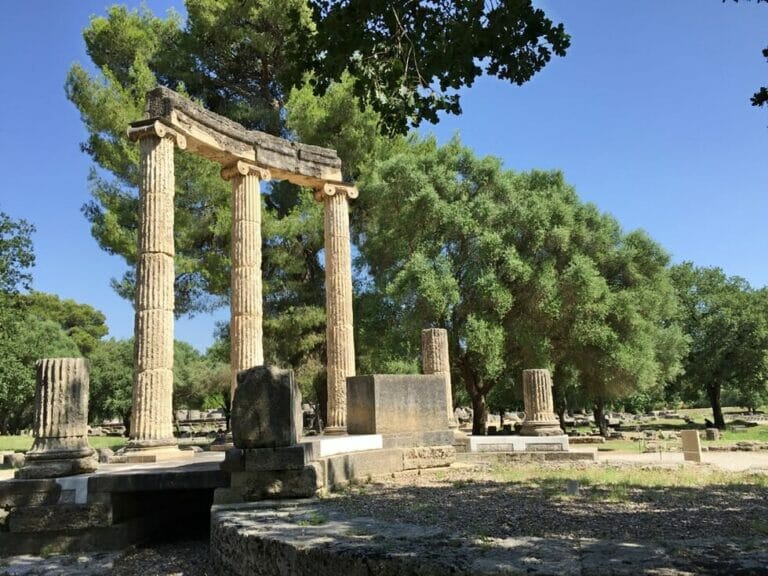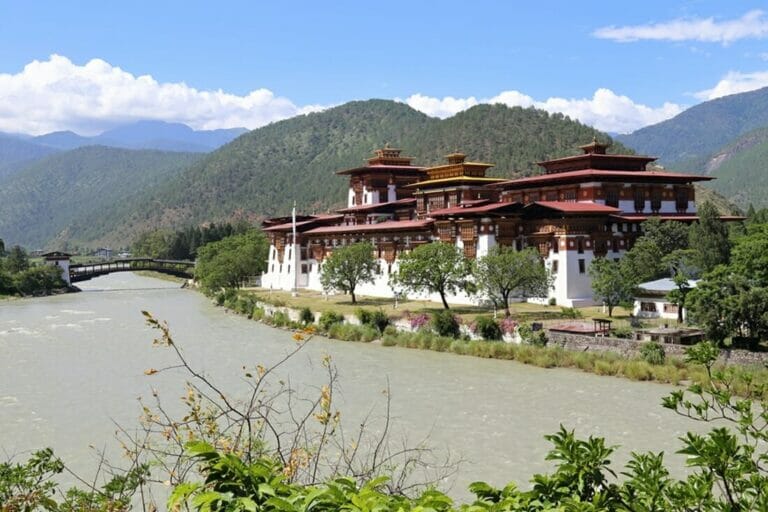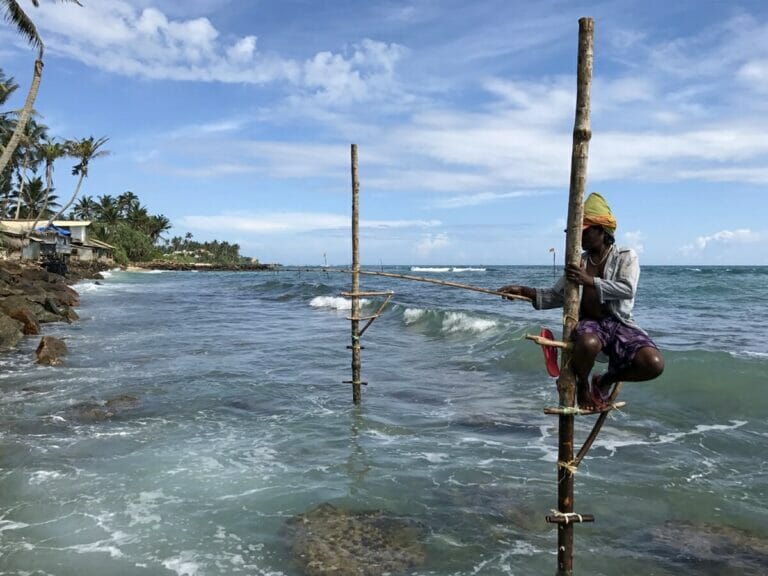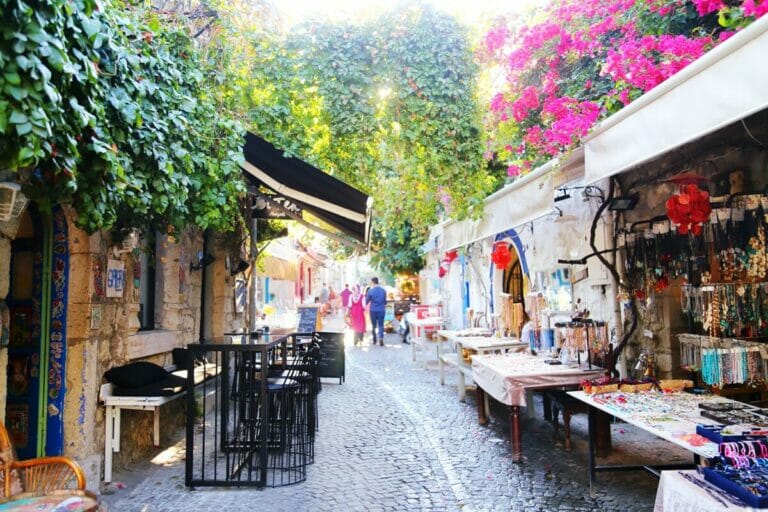Samui Elephant Haven: Ethical Elephant Sanctuary in Koh Samui
Not all elephant sanctuaries in Thailand are created equal. Here is my experience meeting the herd at Samui Elephant Haven in Koh Samui.
Thailand is probably the single most popular destination for elephant interaction experiences – there is no other place in the world with so many elephant shows, sanctuaries and parks.
To this day, tourists still eagerly book and seek out Koh Samui elephant rides, and elephant trekking still takes place day in and day out at famous Koh Samui landmarks such as the Namuang Waterfall.
The good news is that research shows that entertainment activities involving wild animals associated with poor welfare are slowly becoming less popular with visitors to Thailand. World Animal Protection found that in 2019, 28% of tourists undertook or planned an elephant ride…a 12% drop in participation compared to in 2016, when elephant riding was the most popular wildlife tourism activity in Thailand.
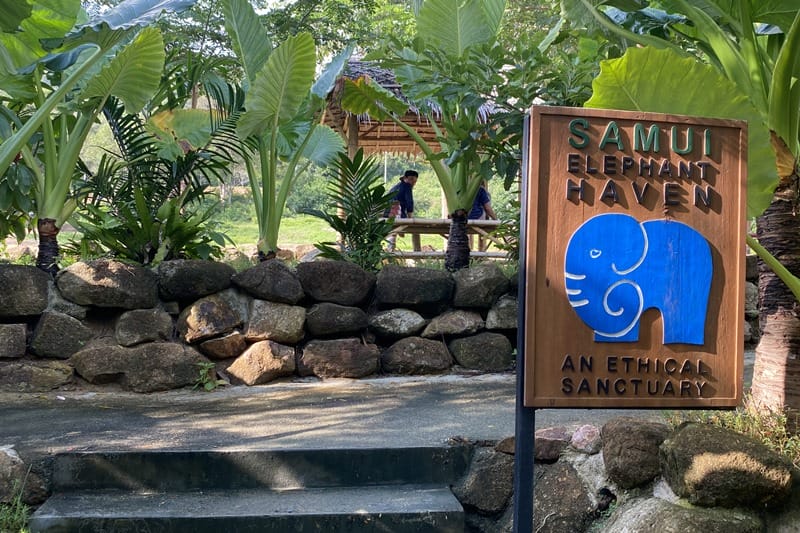
One of the ongoing issues with elephant tourism in Thailand is that everywhere you look, there is an “elephant rescue center”, “elephant retirement home” and “elephant sanctuary”. It can be very confusing and misleading – how do you know if a venue is truly ethical with the best interests of the elephants at heart?
World Animal Protection published two reports on the conditions for elephants used in tourism in Asia. Click here for the PDF report and read the follow-up report here. Many statistics referenced in this post have been sourced from these two research reports.
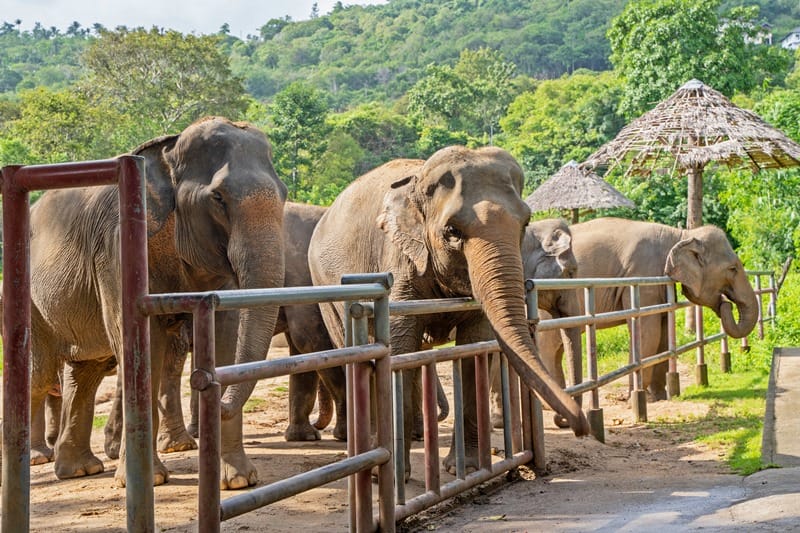
However, the good news is that there are places in Thailand like Elephant Nature Park in Chiang Mai and the Save Elephant Foundation spearheading the way for more elephant tourism operators to transition into more ethical and sustainable programs for their herd.
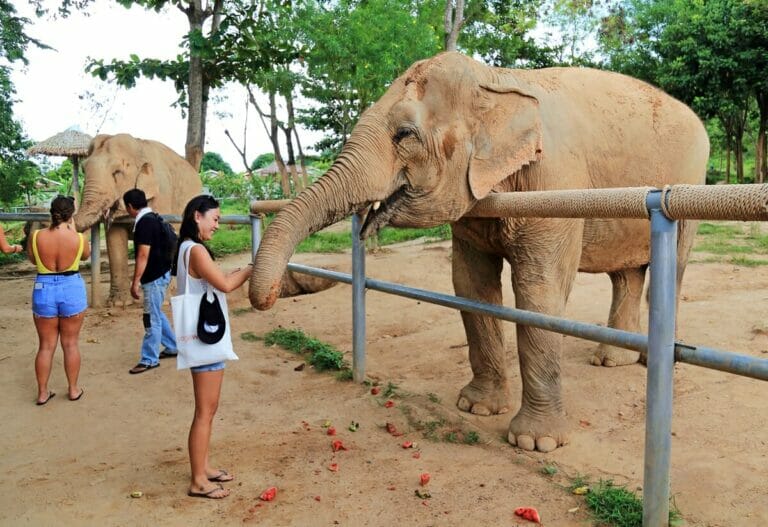
Together with the Samui Elephant Sanctuary which I visited a few years ago, the Samui Elephant Haven is another option for visitors to interact with elephants in Koh Samui responsibly without contributing to their abuse.
Thinking about riding an elephant in Koh Samui? If you are visiting Koh Samui, check out Samui Elephant Haven instead of one of the elephant riding camps on the island! Here is my first-hand experience visiting Samui Elephant Haven.
Looking for more ideas of fun things to do in Koh Samui? Read my guide to visiting Samui Elephant Sanctuary, another accredited ethical elephant sanctuary on the island, or check out my guide to planning a trip to Ang Thong Marine National Park!
The current state of elephant tourism in Thailand
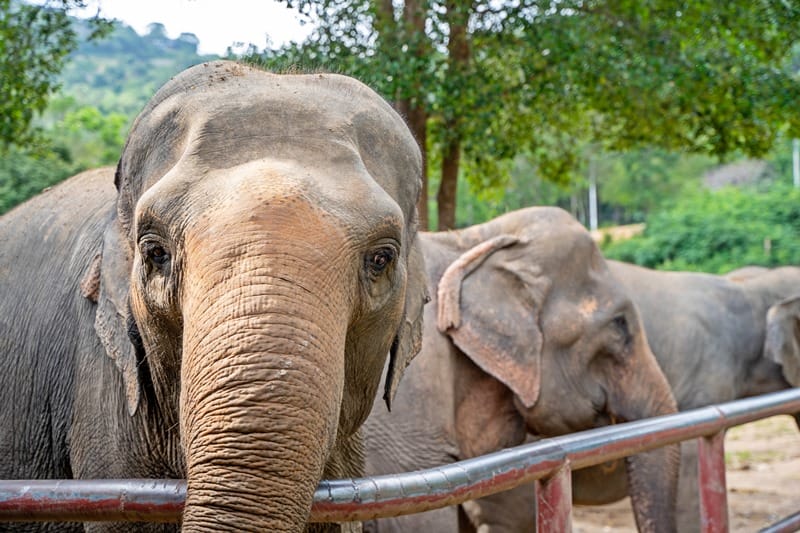
If you are researching ethical elephant experiences in Thailand, here is what you need to know about the elephant tourism industry. The wild elephant population in Thailand (as it is in other parts of the world) is rapidly declining as a result of destruction of natural habitat, poaching and human-elephant conflict.
It is estimated that there are approximately 3,126–3,341 wild elephants in Thailand, and those who are wild are constantly at risk of being killed and separated from their calves, or being enslaved into the tourism or logging industries.
According to the latest report from World Animal Protection, nearly three quarters of the captive elephants used for tourism in Asia are used in Thailand and unfortunately this number has only gone up over the past decade.
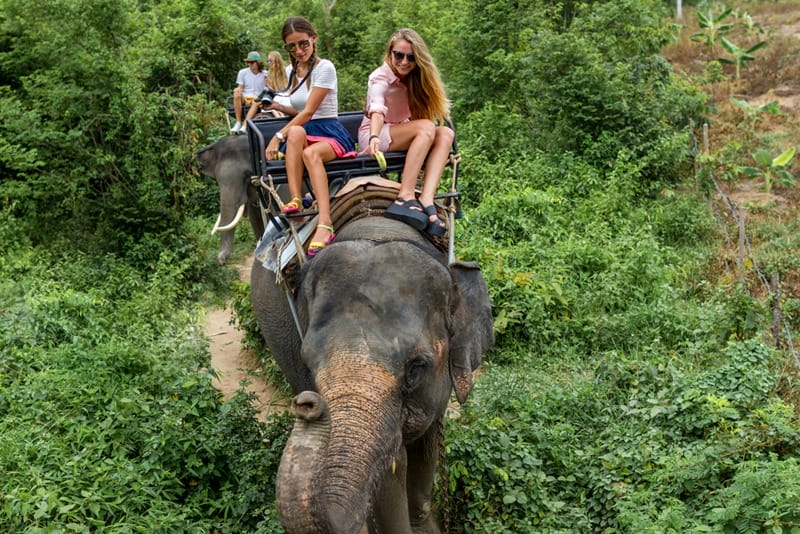
In 2010, 1,644 elephants were used in tourism camps; in 2015, this
number increased to 2,198; and by early 2020, more than 2,800 elephants in Thailand depended on commercial tourism by giving rides, performing in
shows or participating in bathing activities with tourists. This represents a 70% increase in elephants kept for tourism entertainment over 10 years. Similarly, the number of elephant venues has also more than doubled between 2010 and 2020.
These numbers speak for themselves – despite an increase in awareness of elephant welfare, the demand for elephant tourism is still growing.
This makes it even more important for visitors not to be misled by places which call themselves a “rescue centre”, “retirement camp” or “sanctuary” without actually walking the walk. According to WAP’s research, many such places continue to offer what they call “conventional elephant tourism activities” where elephants are not allowed to express natural behaviors and involve frequent short chaining; separation of young calves and mothers; demanding elephant activity schedules; and no intention to prevent elephant breeding.
Interested in reading more about responsible and ethical tourism in Southeast Asia? Click here for 10 things you should know before you visit Southeast Asia!
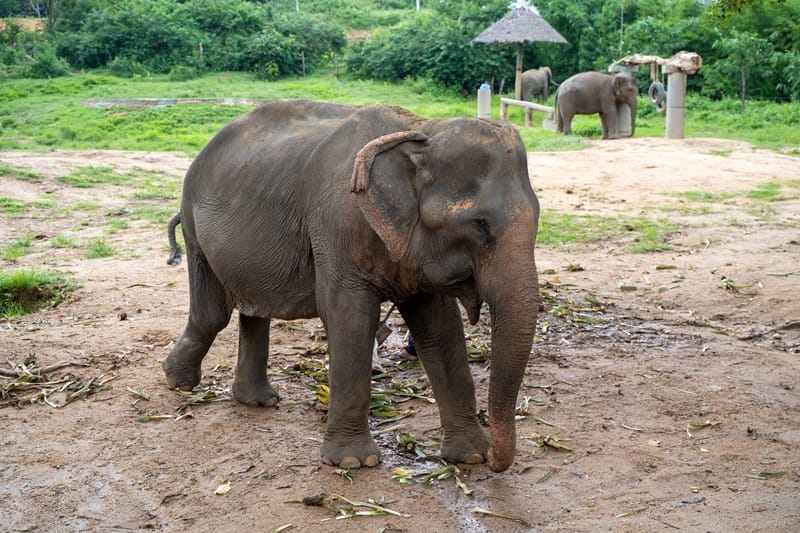
This makes it increasingly important for visitors to Thailand to choose wisely and engage in ethical elephant interaction experiences, and not to be fooled by clever marketing tactics. If you are traveling to Thailand and Koh Samui, Samui Elephant Haven is one such place where elephant welfare is paramount.
What is Samui Elephant Haven?

Samui Elephant Haven is an ethical elephant sanctuary in Koh Samui and is currently home to approximately a dozen rescued elephants – it is one of the best places to visit in Koh Samui in Bophut. Both the Samui Elephant Sanctuary and the Samui Elephant Haven follow the “Saddle Off” model and are supported by the Asian Elephant Projects (which is run by the experienced team at Save Elephant Foundation and Elephant Nature Park in Chiang Mai, founded by Lek Chailert).
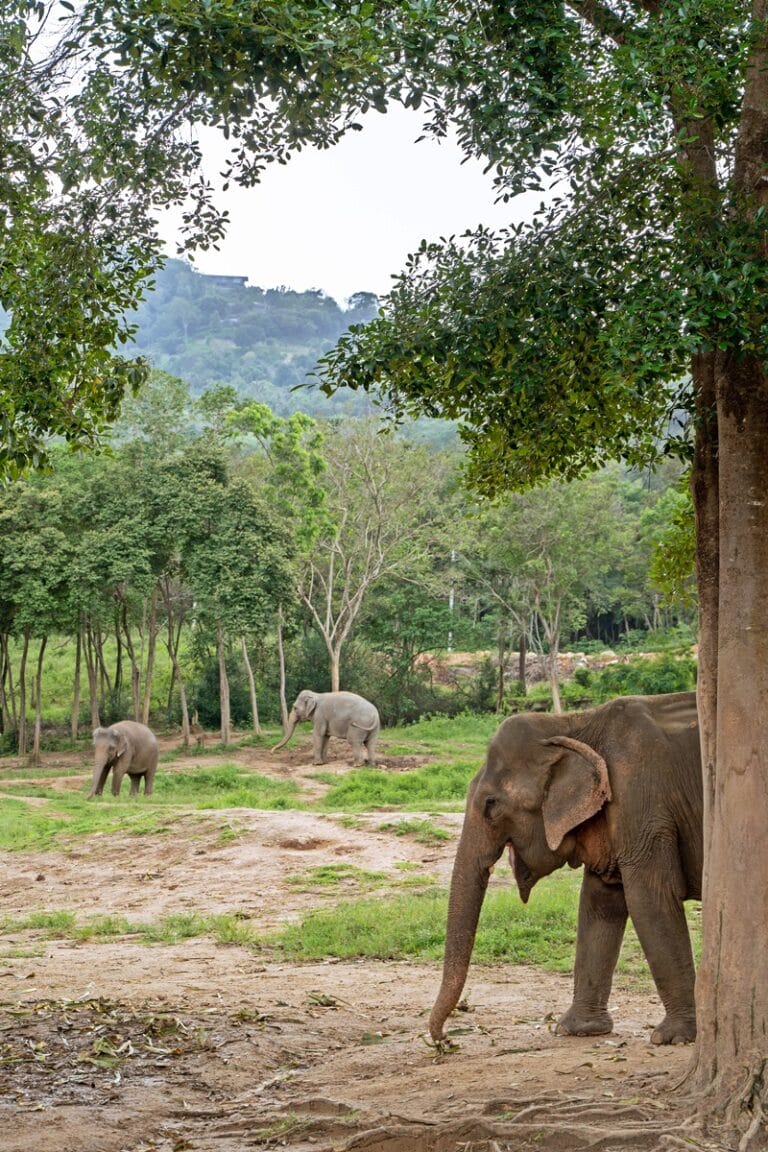
Founded in August 2018, most of the elephants at Samui Elephant Haven have been rescued from the tourist-trekking as well as elephant shows and logging industries. Today, the herd wanders around approximately 23 acres of land with a viewing platform for visitors, jungle and manmade pools. Visitors to Samui Elephant Haven can take part in several tour options to observe, feed and learn about these elephants.
“We are motivated by a desire to free elephants from a hard life working in antiquated forms of elephant tourism and provide a caring home where the elephants can recover from the trauma of their past, and live in nature with peace and dignity.”
Why visit Samui Elephant Haven?

The opportunity to interact with elephants and observe them is humbling, and while I believe that there is no better place for elephants than in their natural habitat, the reality is that it is no longer possible for these particular elephants in Thailand.
If you are looking into taking part in an ethical elephant interaction experience in Thailand, I would recommend visiting and supporting a Koh Samui elephant sanctuary such as this one over a trekking camp or show. Samui Elephant Haven is a no-riding, no-bathing facility.
Most truly ethical elephant sanctuaries do not offer bathing as there is a higher risk of injury for visitors and requires full mahout control, it doesn’t actually allow elephants to play without restrictions, and elephants may be washed multiple times a day which can damage their skin. Read more here.
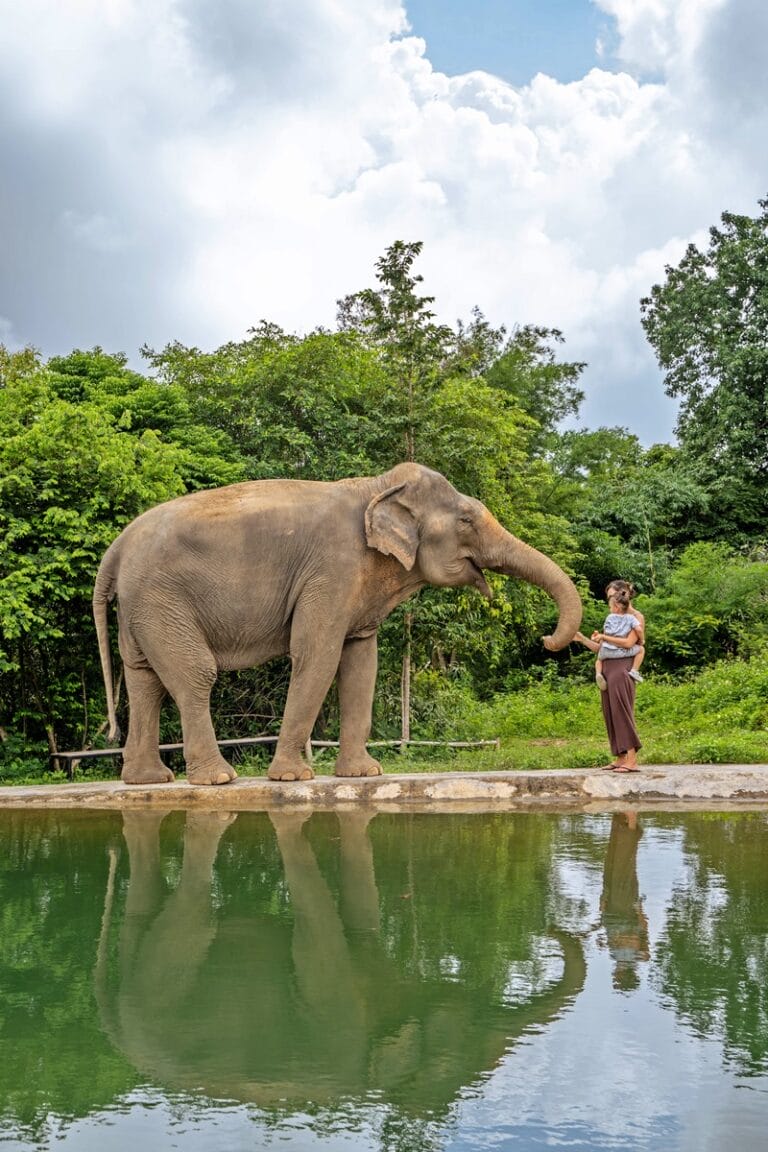
It is also a wonderful half-day activity if you are traveling to Koh Samui with children – our toddler loved watching the elephants wander through the sanctuary, and it is an important first step to helping children understand and experience responsible travel and tourism.
Some food for thought: according to the World Animal Protection organization, “A true elephant-friendly venue is purely observational for visitors, where the safety of visitors and wellbeing of elephants reduce the need to constantly interact and control the animals. They allow for social grouping of compatible elephants and try to provide access to natural habitat as much as possible to encourage expression of natural behaviours.” Read more about how to be an elephant-friendly tourist here.

Aside from feeding time during tours (this is when some elephants from the herd are fed snacks/complementary feeds rather than their main meals by visitors), the elephants at Samui Elephant Haven freely roam the sprawling grounds and are supervised/accompanied by their mahouts.
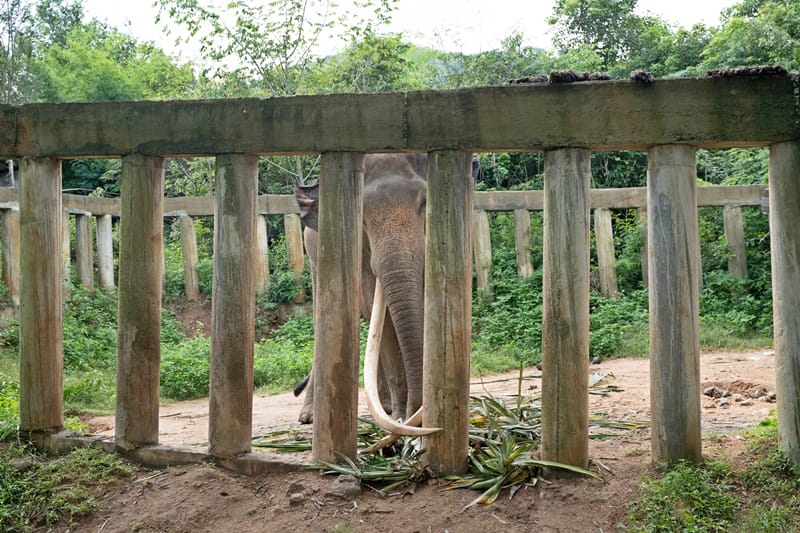
When we visited in early December 2023, there were two male bull elephants who were kept in enclosures but not chained – this is fairly common at elephant sanctuaries for safety purposes and also to prevent breeding. We were informed that at least one would be moved to the new sanctuary grounds across the road to free roam.
There is also one baby elephant, Haven, who was born at Samui Elephant Haven after his mother was rescued – from what we were told, the venue does not breed elephants. He, together with his mother Somboon, have moved across to the new land. Another baby elephant, Luna, sadly succumbed to the Herpes virus in mid-2023.

By visiting Samui Elephant Haven, you can observe elephants express natural behaviours, whilst having the peace of mind that they are receiving the medical care they need and not subjected to abuse or performing stunts and tricks for visitors’ amusement.
How to book a trip to Samui Elephant Haven
Samui Elephant Haven offers an easy online booking system that shows you which dates are available. You can either book the morning tour (9 AM to noon) or afternoon tour (2 to 5 PM). The half-day tour costs 3,000 THB per adult (approx. US$90) or 1,500 THB for children aged 4-11. Children under 4 can participate for free.
These rates include transportation to/from the park and a vegetarian buffet. You can check out all of the different visit options here.
What to expect at Samui Elephant Haven

During your day at Samui Elephant Haven you are picked up at 7-8 AM in the morning or 1-1:30 PM in an A/C van depending on which tour you choose. Once you arrive at the sanctuary, you will be given a quick briefing on the philosophy and history of the park and watch a video on how to interact with the elephants safely.

When we visited in December, there were approximately 8 people (including 2 children) visiting the park during the morning tour – we loved that it was only a small group of people. We also met our lovely guide, Somboon, who was knowledgeable and gave us another no-nonsense briefing on elephant welfare and how we were expected to interact with their herd. This includes washing your hands before feeding the elephants, not teasing them with food and never approaching them from behind (there is no opportunity to do this anyway at Samui Elephant Haven).
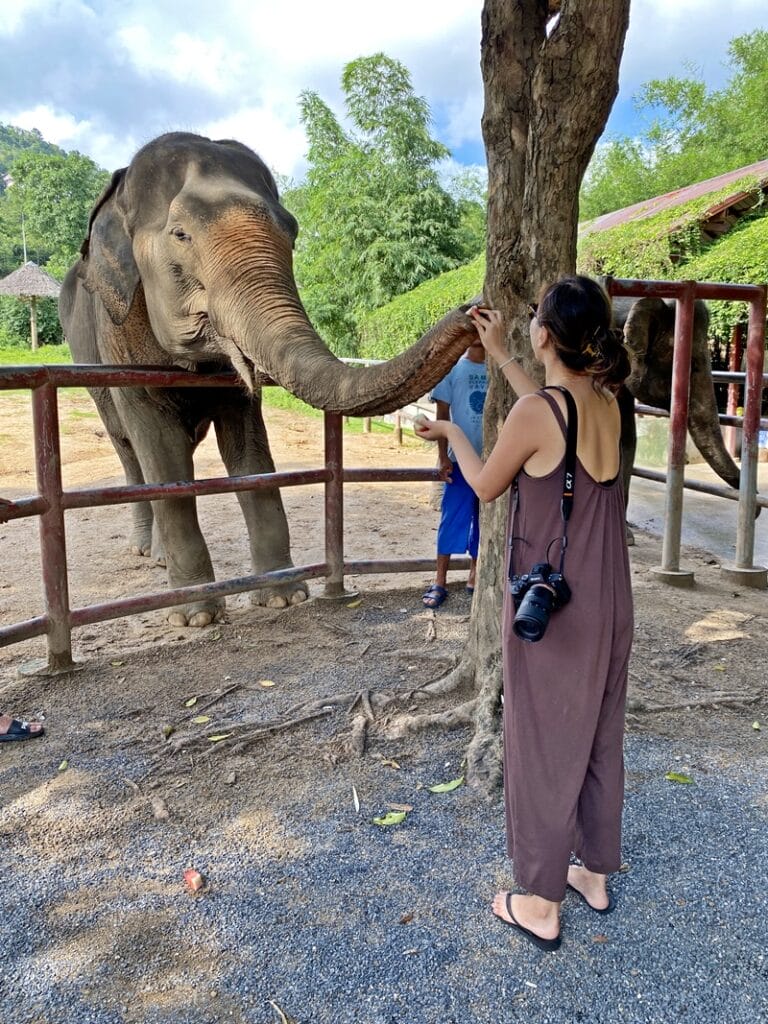
From here, the entire group is taken to a fenced area where you can feed watermelon chunks and banana pieces to half a dozen of the elephant herd. We were given plenty of information about the elephants (in fact, more than I have received at other elephant sanctuaries that I have visited in Asia) including facts about elephant anatomy and diet, as well as unique behavioral and personality traits that certain elephants may exhibit (one elephant was trained to throw darts when it was participating in elephant shows, and therefore often picks up food and hurls it with its trunk).
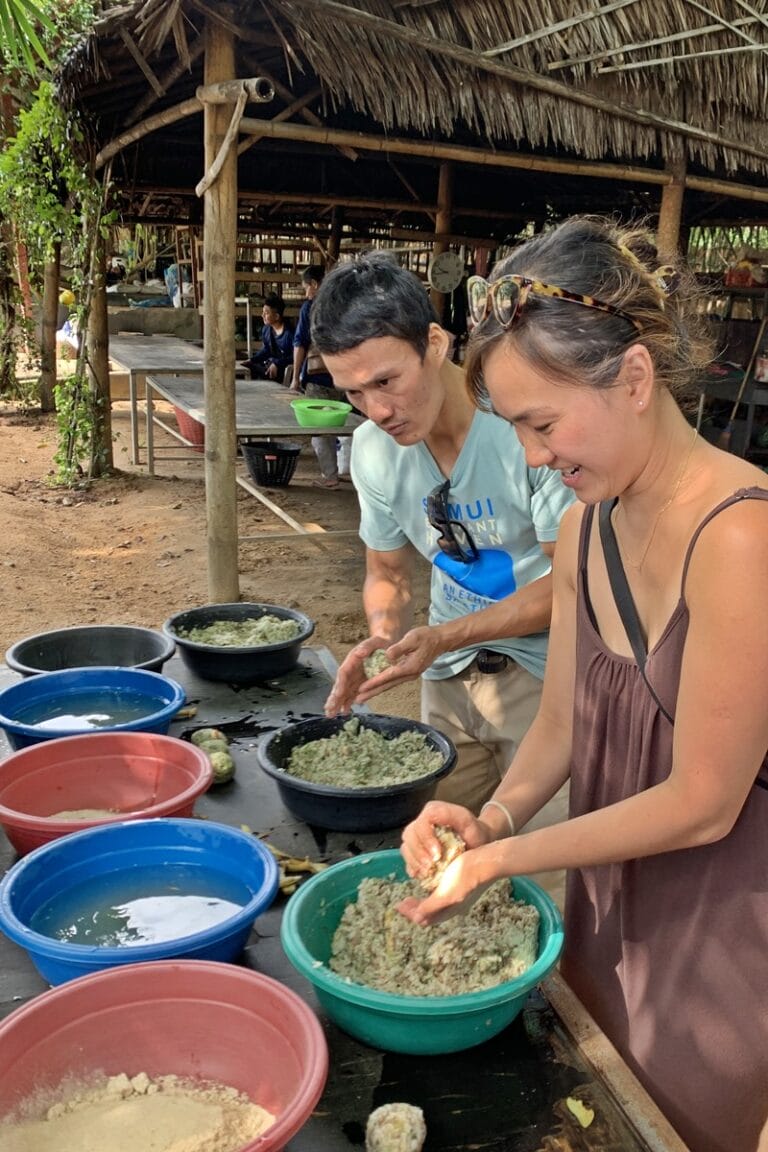
We fed the elephants huge bowls of fruit until the bowls were empty, and then set off onto a quick “elephant cooking lesson” where we made complementary feed rice, bananas and bran balls for the herd. All the while, the elephants are hanging out with their mahouts waiting for their morning snacks. They very very quickly devoured the rice balls we made for them!
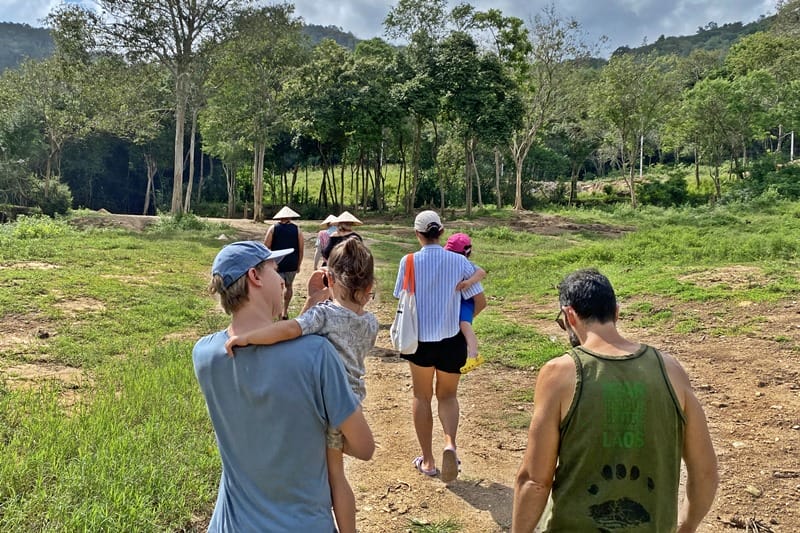
We were then led beyond the viewing platform and into the jungle to explore more of the sanctuary. Somboon continued to tell us about elephant behaviours and how some of their herd had taken to knocking down trees around the property, and how elephants often use mud to protect their skin from the sun.
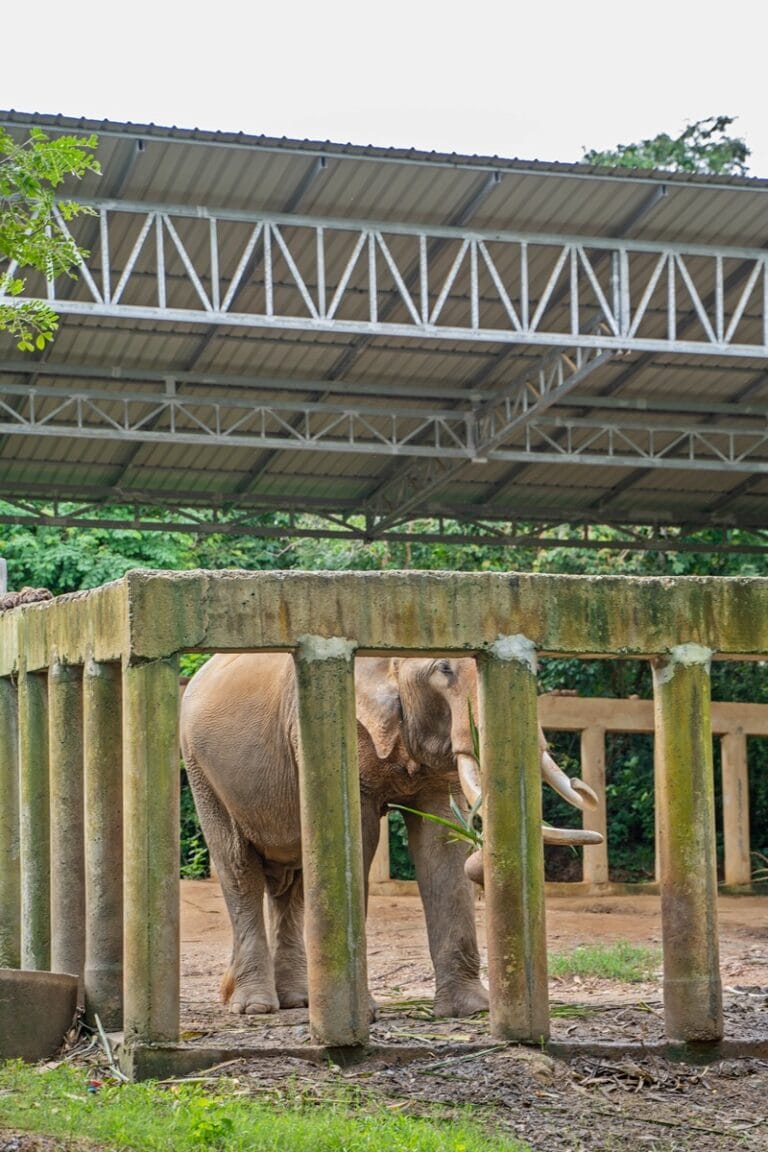
A short jaunt into the jungle later, we came face to face with two bull elephants from the herd, and learned more about male elephants and how sanctuaries like Samui Elephant Haven keep them (and others) safe and healthy. To prevent the two from attacking each other, natural mechanisms like placing elephant dung between the enclosures are used to discourage them from approaching the boundaries.

Next up, we met Sudarat the gatekeeper and former resident of an elephant trekking camp. Together with her mahout, we walked further up to the natural pool and fed her lots and lots of watermelon – she eagerly approached for more, we had to show her our empty hands to prove that we were all out!
While the other couple went on to meet baby Haven, our group of four adults and two toddlers turned around at around 11:15 AM (a little over 2 hours into the tour) to head back to our villa and wrangle them for their lunch and naptime. We also skipped the lunch that was provided by Samui Elephant Haven.

All in all, we were incredibly impressed by the set up at Samui Elephant Haven; it is clear that elephant welfare is their main concern. Compared to some other sanctuaries, I was also blown away by how engaging and knowledgeable the guide, Somboon, was – if you are looking for an educational elephant interaction experience I highly recommend visiting Samui Elephant Haven. You can book your visit here.
Ready to book your trip to the picturesque Koh Samui island? Click here to check availability and rates for Villa Waimarie, or click here to see other highly rated hotels in Koh Samui!
Parting thoughts
The fact is, there are only 30,000 or so Asian elephants left in the world, and visiting Samui Elephant Haven is one way to interact ethically with elephants without contributing to animal cruelty and abuse.

Elephant sanctuaries such as Samui Elephant Haven also rely heavily on tourism in order to provide land, an enormous amount of food, and veterinary care for their elephants as well. They also shoulder the responsibility of supporting the mahouts and their families. After your visit, visitors play an important role when it comes to spreading the word about elephant welfare and the importance of ethical elephant interaction.
That being said, in a perfect world, at the end of the day, the best place for elephants to be is in the wild. There are a handful of places that you can see wild elephants in Thailand such as Khao Yai National Park and Kui Buri National Park.
Where to stay in Koh Samui

I usually stay at Villa Waimarie in Lipa Noi – it is my family’s timeshare property and is on one of the most pristine and uncrowded beaches in Koh Samui, located about a 45-minute drive from Bophut where Samui Elephant Haven is located. The beachfront villa has 6 bedrooms, a tennis court, an indoor and outdoor lounge area, pool and amazing kitchen.
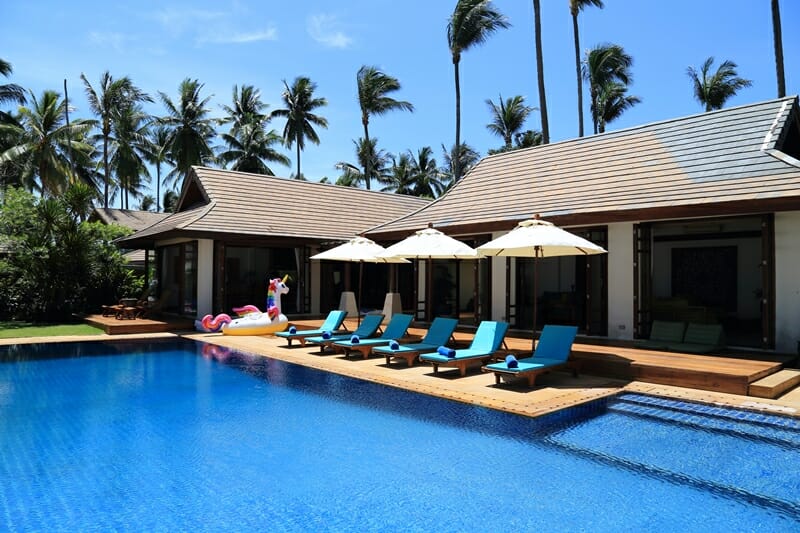
It’s a fantastic luxury villa in Koh Samui to book if you have a large group of people, and serves up the most incredible Thai food from the in-house chef. Click here to check availability and rates for Villa Waimarie.
Alternatively, Samui Elephant Haven recently partnered with Wild Cottages to open a brand new boutique hotel that overlooks a new sanctuary (across from the original sanctuary space) that spans approximately 10 acres. This has allowed a few of the herd to move over to roam around the larger space and Wild Cottages similarly offers elephant interaction and observation experiences led by Samui Elephant Haven.
As this recently opened in December 2023 after our latest Koh Samui trip I don’t have any personal experience staying at Wild Cottages Elephant Sanctuary. However, my understanding is that any elephant experiences follow the format and policies of the main Samui Elephant Haven sanctuary, and the elephants are still under the care of the Samui Elephant Haven team. You can check reviews and availability here or click here to see other highly rated hotels in Koh Samui!
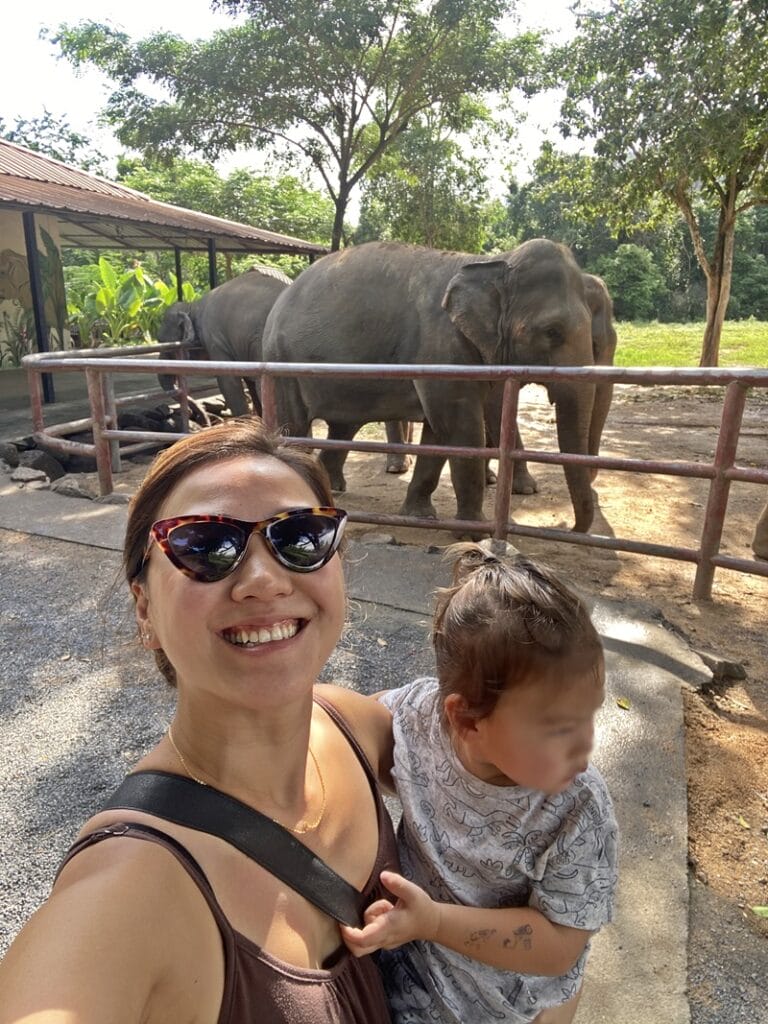
Have you visited Samui Elephant Haven or can you recommend some other ethical elephant sanctuaries in Thailand? Let me know in the comments section below!
More resources on elephants in Thailand here:
- WWF-Thailand
- Thai Elephant Conservation Center (government entity)
- Center of Excellence in Elephant and Wildlife Research at Chiang Mai University.
- Elephants. Not Commodities. research report by WAP
You might also want to read these guides:
- Thinking about riding elephants in Thailand? There are more ethical alternatives like Elephant Nature Park in Chiang Mai and Samui Elephant Sanctuary in Koh Samui
- Looking for more ideas of fun things to do in Koh Samui? Check out my guide to planning a trip to Ang Thong Marine National Park and my Koh Samui sightseeing guide
- Interested in reading more about ethical elephant experiences? Click here for more sanctuaries, orphanages and parks that you can visit around the world
- Headed to Thailand? Check out this 10 day Thailand itinerary for some planning ideas
- Read more about responsible and ethical tourism in Southeast Asia – click here for 10 things you should know before you visit Southeast Asia
Pin this for later!
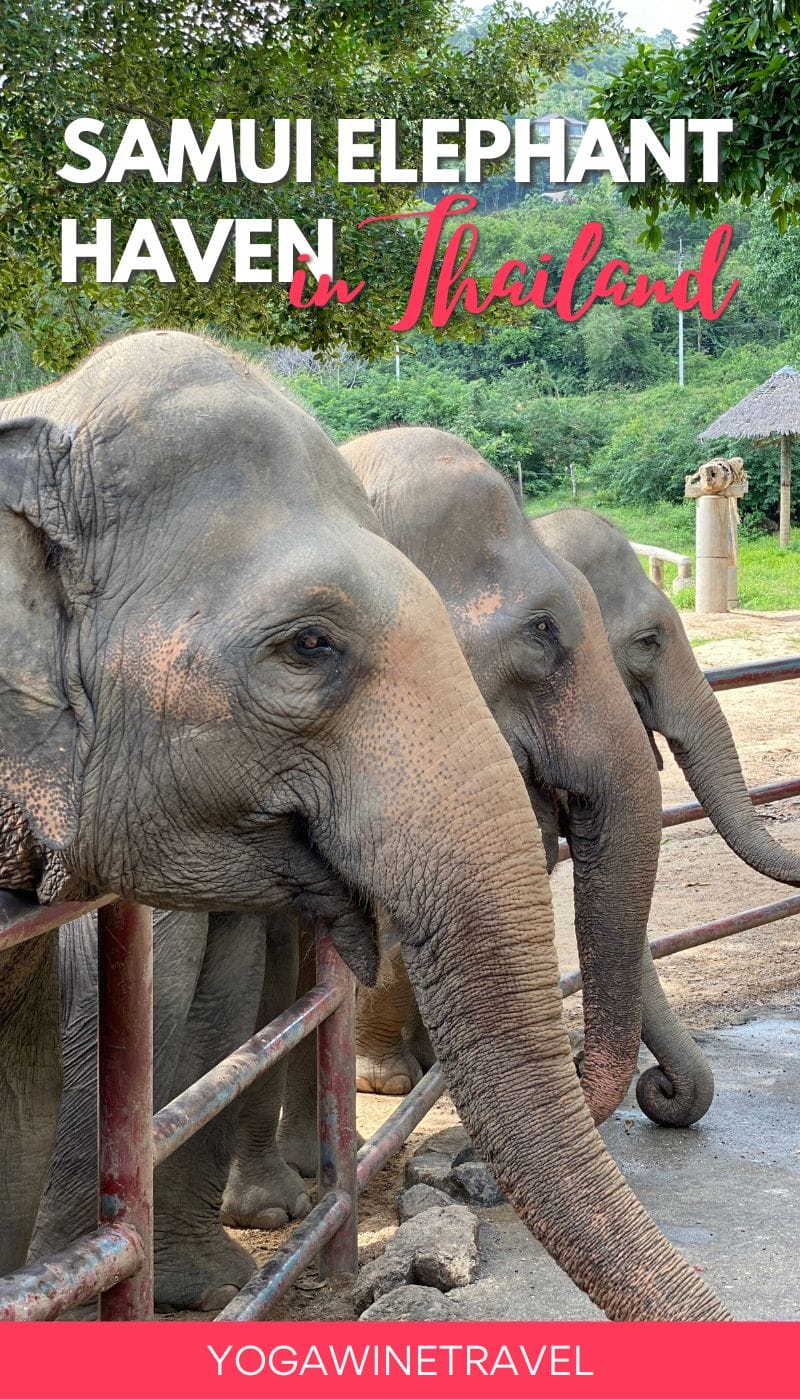

This post contains affiliate links. If you choose to book using these links, I will earn a small commission at no extra cost to you. Thank you for supporting my website by using these links.
Enjoyed reading this article? Subscribe to the mailing list!
* Unsubscribe at any time. Your e-mail address will only ever be used to send the occasional Yoga, Wine & Travel newsletter.



